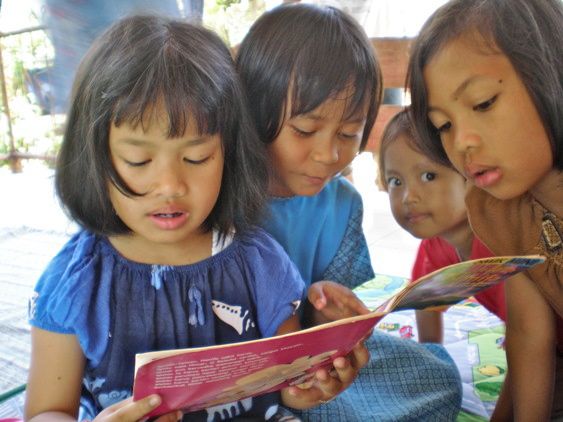Mencerdaskan Bangsa - An Inquiry into the Phenomenon of Taman Bacaan in Indonesia
September 20, 2008, [MD]
During my undergraduate degree in International Development Studies, we had to spend a year working in a developing country, and develop a thesis based on primary research conducted in that country. I spent my year working in Jakarta (for CARE). While there, I came across the phenomenon of community-run libraries, which was extremely widespread and fascinating. While trying to understand the phenomenon better, I realized that there was extremely little research available on this, and I decided to try to both map the movement and its history, and also try to investigate what kind of factors would have led or enabled this movement to happen in Indonesia, at a certain place and a certain time in history.

Children reading at the Taman Bacaan in Arjasari
I early made a committment to making my research available both as open access, and in a fully translated version in Indonesian as well. I really want my research to be available to everyone in Indonesia, both activists and academics, both to make a contribution to the scholarly discourse in Indonesia, but also to be able to receive much more feedback about the possible mistakes that I have made, so that my subsequent writings on this topic can be better informed. Getting it translated was a long and slightly painful journey, and I might write about this later, but I finally have a version that I am more or less happy with. Although the thesis has been available at T-SPACE since April, I have held back on sharing it with most of the people that assisted me, because I wanted the Indonesian version to be available for distribution.
I am contributing both language versions to E-LIS, but their approval is taking too long, so I am also publishing the files here on my blog.
English abstract:
Since 2001, a movement of individuals, neighbourhood and community organizations and NGOs starting and running their own libraries has emerged in Indonesia. Called Taman Bacaans (TBs) - reading gardens - these simple libraries, often hosted in somebody’s house, or in a community building, provide easy and informal access to books, as well as frequent literacy programming. This thesis traces the historical heritage of these TBs back to the early renting libraries of peranakan Chinese in the 19th century, through Balai Pustaka and the public library movement under Sukarno. The modern TB emerges in the 1980s, the government attempts a wide-scale implementation of TBs in the 1990s, and a community movement finally emerges in 2001.\ Using interviews with informants and newspaper articles, blogs, mailing lists, and NGO and government reports, I describe the process of how the TB movement emerges in Bandung and Yogyakarta. I also identify a number of factors that enabled and supported the movement: inspiring individual role-models, “best-case” libraries, networks and the roles of Islam and nationalism. Finally I provide an overview of the situation today, combining government statistics with the results of a survey conducted in Jakarta, and show that there are three kinds of TBs: those set-up by national, regional or local government (TBMs), those funded by large-scale donors, and independent TBs grounded in the local communities. I conclude with a number of recommendations for government and donors.
Indonesian abstract:
Sejak tahun 2001, di Indonesia telah ada suatu pergerakan dari kalangan individu, tingkat rukun tetangga (RT) dan organisasi kemasyarakatan serta LSM yang memulai dan menjalankan perpustakaan mereka. Perpustakaan-perpustakaan sederhana ini dikenal sebagai Taman Bacaan (TB). Lokasi mereka sering di rumah seseorang atau di dalam sebuah bangunan umum, dan menyediakan akses yang mudah dan bersifat informal untuk buku-buku dan banyak kegiatan-kegiatan literasi. Tesis ini menelusuri kembali sejarah tentang TB mulai dari masa persewaan buku oleh keturunan Cina di abad 19, melalui Balai Pustaka dan pergerakan perpustakaan umum di masa pemerintahan Sukarno. TB modern mulai muncul di tahun 1980, lalu pemerintah mencoba menerapkan TB berskala besar di tahun 1990, dan pada akhirnya pergerakan masyarakat muncul di tahun 2001.\ Berdasarkan wawancara dengan para sumber informasi, artikel-artikel di surat kabar, blog dan milis serta laporan NGO dan pemerintah, saya memaparkan proses munculnya pergerakan TB di Bandung dan Yogyakarta. Saya juga menunjukkan sejumlah faktor-faktor yang dapat dan mendukung pergerakan tersebut, yaitu: inspirasi tokoh teladan, “perpustakaan kasus terbaik”, jaringan-jaringan serta peran Islam dan nasionalisme. Di bagian akhir saya memberikan ihktisar mengenai situasi hari ini, yang menggabungkan statistik pemerintah dengan hasil survei yang dilakukan di Jakarta, yang menunjukkan ada tiga jenis TB, yaitu: TB yang dibentuk oleh pemerintah nasional, regional dan daerah, TB yang didanai oleh donor berskala-besar, dan TB independen yang didirikan oleh masyarakat setempat. Saya juga melampirkan beberapa rekomendasi bagi pemerintah dan para penyumbang.
Files: English thesis and the Indonesian translation (without illustrations to reduce filesize)
Both are under Creative Commons BY license. I am eager that as many people as possible that would be interested in this topic are able to come across it, so feel free to share it with others that are interested. I am also very happy to receive feedback and other perspectives, whether in comments or by email (shaklev at gmail dot com).
Stian
Stian Håklev September 20, 2008 Toronto, Canada comments powered by Disqus